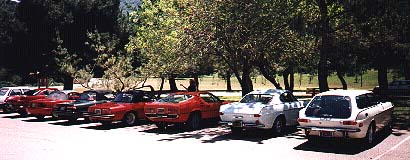 |
 |
 |
 |
Alfa Romeo / Volvo Rally '97"You know," said Marsha as the US 101 turned away from the coast and headed our 122S uphill into the Santa Ynez mountains, "I'd really like us to win this year."
We were on our way to the start of that automotive version of "connect the dots" -- the annual time-speed-distance rally against the Alfa Romeo Owner's Club of Central California. The rally is organized by John Self of AROCCC and Karl Grimm of our club, Volvo Sports America. Now, realize that this is not a race. The rally is run entirely on public roads, the average speeds are within posted limits, and receiving a traffic citation is cause for disqualification. The object is to arrive at surprise checkpoints along the route at the correct instant -- each second early or late adds a point to your score. At the end, the car with the lowest accumulated points for all the checkpoints wins.
VSA Chapter President Bill Webb showed up in this new V70 to help man the checkpoints. John and Karl measure each year's course with enormous accuracy, and they pick out sixty or seventy landmarks, primarily words on signs. Each car gets a set of directions, and the goal is to spot the landmarks and change speed, turn, or stop at each landmark as directed. The directions are clear, the landmarks are all in plain sight, and, if you just turn in the right places and drive the prescribed speeds, you get to the checkpoints at the correct times and you win. That's the theory. In fact, practice diverges from theory for several reasons. First, notice that I said public roads, which have things like traffic, stop signals, and cattle on them as well as Volvos and Alfas. Second, while the directions may call for a speed of 38 MPH on a road posted at 40, that is the average speed to go, regardless of all those yellow 15 MPH "advisory" signs as the road snakes down off a ridge into a canyon. Third, John and Karl have been designing rallies for some thirty years, and they know all the subtle, subtle tricks that make overloaded, trying-to-make-up-time-for-the-last-mistake drivers and navigators go wrong (not that they'd ever admit it -- just ask them). Consider these factors, and I think you will see how things that say "ipd," "Bilstein," "Weber" and "Chronograph" on them can come into play.
We watched as car number 4, seemingly still running about the correct minute ahead of us, rolled into their first pitfall -- the first instruction out of the checkpoint read R before "Lompoc" (the quotes around "Lompoc" indicating a literal word on a sign). Unfortunately for car number 4, the sign also had a large arrow pointing left, and that's the way they turned. They realized the mistake pretty quickly, and soon came howling past us, trying to figure out how much time to make up.
Leaving the pause, Alfa number 3 turned the reverse way back up the road. They soon reappeared going in the right direction. Very clever -- they'd gone back to the last stop and started fresh from there, greatly simplifying the time calculation. However, they got confused about which stop sign was which and proceeded happily straight down the road, still looking for the turn at the next stop. See you at the picnic, folks.
We seemed to stay in pretty good shape through the next checkpoint (with car number 4 passing us several times -- who knows where they'd been), but missed a landmark on the third leg and kept on driving until we came to a "T" intersection with no clue which way to go. About the time we felt we'd caught up, we found ourselves winding up a mountain road, about as fast as we could safely go, just trying to maintain the mandated average speed -- and, at the top, a checkpoint, and the end of the rally at a small county park. We had no idea where we were, but it was obviously the right place -- which is characteristic of the whole rally process.
 As cars continued to arrive, we sat down with the now-revealed list of "true times," and calculated our running time for each leg compared to the ideal. The first few legs were pretty close, but we were three whole minutes fast for the last. How could we have gotten lost, backtracked, and then overcompensated so badly? I suspected John and Karl had led us into a tiny little trap somewhere along the route. Oh well, it wouldn't be the first time. I said as much to John as I went back to the car to get our picnic lunch. "The thing is," John said, "Everyone is fast on the last leg -- what do you think went wrong?" I had no idea.
The officials went into a huddle as the last stragglers drifted in. Yes, it meant just that. Marsha got her wish -- we had won.
|
|||||||||||||||||||||